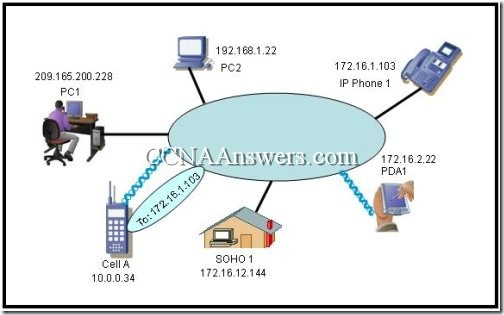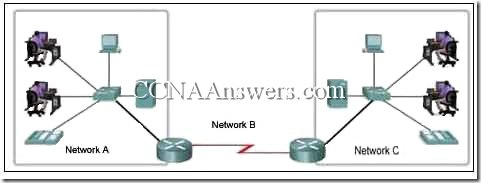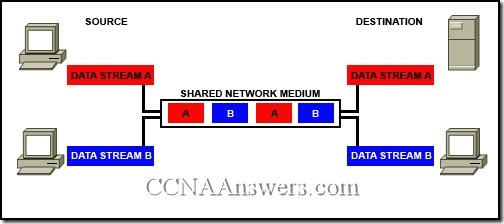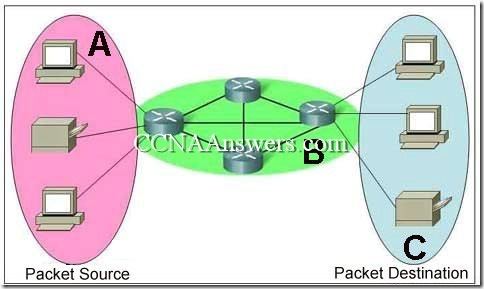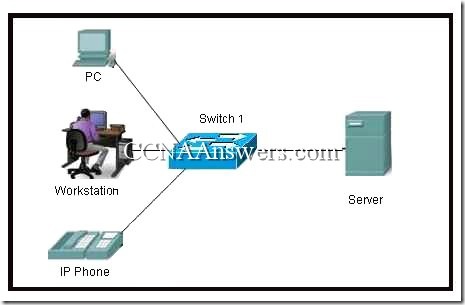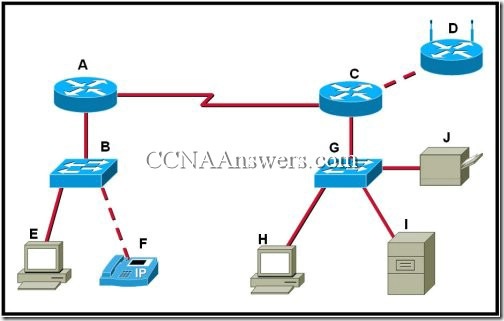CCNA V4 Chap 2
-
Which statements correctly identify the role of intermediary devices in the network? (Choose three.
-
Determine pathways for data
-
Initiate data communications
-
Retime and retransmit data signals
-
Originate the flow of data
-
Manage data flows
-
Final termination point for data flow
-
The CCNA V4 Chap 2 quiz assesses knowledge on network intermediary devices, protocols, encapsulation functions, OSI and TCP\/IP models, and PDUs. It's designed to enhance understanding of data pathways, error detection, and network communication structure.

Quiz Preview
- 2.
Select the statements that are correct concerning network protocols. (Choose three.)
-
Define the structure of layer specific PDU’s
-
Dictate how to accomplish layer functions
-
Outline the functions necessary for communications between layer
-
Limit the need for hardware compatibility
-
Require layer dependent encapsulations
-
Eliminate standardization among vendors
Correct Answer(s)
A. Define the structure of layer specific PDU’s
A. Outline the functions necessary for communications between layer
A. Require layer dependent encapsulationsExplanation
Network protocols define the structure of layer-specific PDU's, which are the data units exchanged between layers. They also outline the functions necessary for communication between layers, ensuring that each layer performs its specific tasks. Additionally, network protocols require layer-dependent encapsulations, meaning that each layer adds its own header and footer to the data as it is passed down the protocol stack. These encapsulations help ensure that the data is properly understood and processed by the receiving layers.Rate this question:
-
- 3.
What are two functions of encapsulation? (Choose two.)
-
Tracks delay between end devices
-
Enables consistent network paths for communication
-
Identifies pieces of data as part of the same communication
-
Ensures that data pieces can be directed to the correct receiving end device
Correct Answer(s)
A. Identifies pieces of data as part of the same communication
A. Ensures that data pieces can be directed to the correct receiving end deviceExplanation
Encapsulation is a process in which data and its corresponding methods are bundled together into a single unit called an object. This helps in organizing and structuring the code. The two functions of encapsulation mentioned in the answer are:
1. Identifies pieces of data as part of the same communication: Encapsulation allows related data to be grouped together, making it easier to manage and understand the communication between different components of a system.
2. Ensures that data pieces can be directed to the correct receiving end device: By encapsulating data and methods within objects, encapsulation ensures that the data is accessed and manipulated only by the intended recipient, preventing unauthorized access and ensuring data integrity.Rate this question:
-
- 4.
What is a primary function of the trailer information added by the data link layer encapsulation?
-
Supports error detection
-
Ensures ordered arrival of data
-
Provides delivery to correct destination
-
Identifies the devices on the local network
-
Assists intermediary devices with processing and path selection
Correct Answer
A. Supports error detectionExplanation
The primary function of the trailer information added by the data link layer encapsulation is to support error detection. This trailer contains a checksum or a cyclic redundancy check (CRC) value that allows the receiving device to verify if the data has been corrupted during transmission. By comparing the checksum or CRC value with the received data, errors can be detected and appropriate actions can be taken to ensure data integrity.Rate this question:
-
- 5.
Which two layers of the OSI model have the same functions as the TCP/IP model Network Access Layer? (Choose two.)
-
Network
-
Transport
-
Physical
-
Data Link
-
Session
Correct Answer(s)
A. Physical
A. Data LinkExplanation
The Network Access Layer in the TCP/IP model is responsible for the physical transmission of data and the logical addressing of devices on the network. The Physical layer in the OSI model also deals with the physical transmission of data, such as the electrical signals and cabling used. The Data Link layer in the OSI model is responsible for the logical addressing of devices on the network, similar to the Network Access Layer. Therefore, the Physical and Data Link layers in the OSI model have the same functions as the TCP/IP model's Network Access Layer.Rate this question:
-
- 6.
What is a PDU?
-
Corruption of a frame during transmission
-
Data reassembled at the destination
-
Retransmitted packets due to lost communication
-
A layer specific encapsulation
Correct Answer
A. A layer specific encapsulationExplanation
A PDU, or Protocol Data Unit, is a layer specific encapsulation. This means that it is a unit of data that is created at a specific layer of the network protocol stack. Each layer has its own PDU format, which includes the necessary information for that layer to process and transmit the data. This encapsulation allows for the data to be properly handled and transmitted through the network, ensuring that it reaches its destination correctly.Rate this question:
-
- 7.
Refer to the exhibit. “Cell A” at IP address 10.0.0.34 has established an IP session with “IP Phone 1″ at IP address 172.16.1.103. Based upon the graphic, which device type best describes the function of wireless device “Cell A?”
-
The destination device
-
An end device
-
An intermediate device
-
A media device
Correct Answer
A. An end deviceExplanation
Based on the information provided in the exhibit, "Cell A" at IP address 10.0.0.34 has established an IP session with "IP Phone 1" at IP address 172.16.1.103. This indicates that "Cell A" is the source device initiating the session, making it an end device.Rate this question:
-
- 8.
Refer to the exhibit. Which three labels correctly identify the network types for the network segments that are shown? (Choose three.)
-
Network A — WAN
-
Network B — WAN
-
Network B — MAN
-
Network C — LAN
-
Network C — WAN
-
Network A – LAN
Correct Answer(s)
A. Network B — WAN
A. Network C — LAN
A. Network A – LANExplanation
The correct labels for the network segments are Network B as WAN, Network C as LAN, and Network A as LAN. This is because WAN (Wide Area Network) refers to a network that covers a large geographical area, typically connecting multiple LANs. LAN (Local Area Network) refers to a network that covers a small area, such as a home, office, or building. Therefore, Network B and Network C fit the descriptions of WAN and LAN respectively. Network A is also a LAN because it is a local network within a specific area.Rate this question:
-
- 9.
Which characteristic correctly refers to end devices in a network?
-
Manage data flows
-
Originate data flow
-
Retime and retransmit data signals
-
Determine pathways for data
Correct Answer
A. Originate data flowExplanation
End devices in a network refer to devices that initiate or generate data flow. These devices are the source of data transmission within the network. They can be computers, smartphones, servers, or any device that sends data to other devices in the network. The term "originate data flow" accurately describes the role of end devices in a network. They are responsible for initiating communication and sending data to other devices.Rate this question:
-
- 10.
Which three statements best describe a Local Area Network (LAN)? (Choose three.)
-
A LAN is usually in a single geographical area.
-
The network is administered by a single organization.
-
The connection between segments in the LAN is usually through a leased connection.
-
The security and access control of the network are controlled by a service provider.
-
A LAN provides network services and access to applications for users within a common organization.
-
Each end of the network is generally connected to a Telecommunication Service Provider (TSP).
Correct Answer(s)
A. A LAN is usually in a single geographical area.
A. The network is administered by a single organization.
A. A LAN provides network services and access to applications for users within a common organization.Explanation
A Local Area Network (LAN) is usually in a single geographical area, meaning it covers a small physical area such as an office building or campus. The network is administered by a single organization, which means that one entity is responsible for managing and maintaining the network. A LAN provides network services and access to applications for users within a common organization, allowing employees or members of the organization to connect and share resources.Rate this question:
-
- 11.
Refer to the exhibit. Which networking term describes the data interleaving process represented in the graphic?
-
Piping
-
PDU
-
Streaming
-
Multiplexing
-
Encapsulation
Correct Answer
A. MultiplexingExplanation
The correct answer is multiplexing. Multiplexing refers to the process of combining multiple data streams into a single stream for transmission over a shared medium. In the graphic, it appears that multiple data streams are being combined into a single stream, which is characteristic of multiplexing.Rate this question:
-
- 12.
What is the primary purpose of Layer 4 port assignment?
-
To identify devices on the local media
-
To identify the hops between source and destination
-
To identify to the intermediary devices the best path through the network
-
To identify the source and destination end devices that are communicating
-
To identify the processes or services that are communicating within the end devices
Correct Answer
A. To identify the processes or services that are communicating within the end devicesExplanation
Layer 4 port assignment is used to identify the processes or services that are communicating within the end devices. Layer 4 of the OSI model is the transport layer, which is responsible for establishing connections, managing data flow, and ensuring reliable delivery of data between end devices. By assigning specific port numbers to different processes or services, the transport layer can distinguish between them and ensure that the data is correctly routed to the appropriate destination. This allows for efficient communication and enables multiple services to run simultaneously on the same device.Rate this question:
-
- 13.
What device is considered an intermediary device?
-
IP phone
-
Laptop
-
Printer
-
Switch
-
File server
Correct Answer
A. SwitchExplanation
A switch is considered an intermediary device because it acts as a bridge between multiple devices in a network. It receives data packets from one device and forwards them to the appropriate destination device based on the MAC address. It helps to create a network by connecting multiple devices together and facilitating communication between them. Unlike IP phones, laptops, printers, and file servers, which are endpoint devices, a switch does not generate or process data itself but rather facilitates the transfer of data between devices.Rate this question:
-
- 14.
Refer to the exhibit. Which term correctly identifies the device type that is included in the area B?
-
End
-
Transfer
-
Intermediary
-
Source
Correct Answer
A. IntermediaryExplanation
The term "intermediary" correctly identifies the device type that is included in area B. An intermediary device is a networking device that connects multiple networks together, such as switches or routers. These devices help facilitate communication between different networks by receiving data packets from one network and forwarding them to another. In this case, the device in area B is likely acting as a bridge between two networks, making it an intermediary device.Rate this question:
-
- 15.
Refer to the exhibit. What type of network is shown?
-
WAN
-
MAN
-
LAN
-
WLAN
Correct Answer
A. LANExplanation
The network shown in the exhibit is a Local Area Network (LAN). A LAN is a network that connects devices within a small geographical area, such as a home, office, or building. It typically uses Ethernet cables or Wi-Fi to connect devices and allows for the sharing of resources, such as printers and files, among connected devices.Rate this question:
-
- 16.
Which layer encapsulates the segment into packets?
-
Physical
-
Data link
-
Network
-
Transport
Correct Answer
A. NetworkExplanation
The network layer encapsulates the segment into packets. This layer is responsible for routing the packets across different networks and ensuring that they reach their intended destination. It adds necessary headers and information to the segment to create a packet that can be transmitted over the network.Rate this question:
-
- 17.
What can be identified by examining the network layer header?
-
The destination device on the local media
-
The destination host address
-
The bits that will be transferred over the media
-
The source application or process creating the data
Correct Answer
A. The destination host addressExplanation
By examining the network layer header, one can identify the destination host address. The network layer header contains information about the source and destination IP addresses, among other things. Therefore, analyzing the network layer header allows us to determine the specific host to which the data is being sent.Rate this question:
-
- 18.
Refer to the exhibit. Which set of devices contains only end devices?
-
A, C, D
-
B, E, G, H
-
C, D, G, H, I, J
-
D, E, F, H, I, J
-
E, F, H, I, J
Correct Answer
A. E, F, H, I, JExplanation
The correct answer is E, F, H, I, J. In a network, end devices are the devices that are the source or destination of data. In this case, devices E, F, H, I, J are the only ones that are not connected to any other devices in the exhibit. Therefore, they are the only devices that can be classified as end devices.Rate this question:
-
- 19.
During the encapsulation process, what occurs at the data link layer?
-
No address is added.
-
The physical address is added.
-
The logical address is added.
-
The process port number is added.
Correct Answer
A. The physical address is added.Explanation
During the encapsulation process at the data link layer, the physical address is added. The data link layer is responsible for creating frames and adding necessary information to them before they are transmitted over the network. One of the important pieces of information added at this layer is the physical address, also known as the MAC address. The MAC address uniquely identifies the network interface card of a device and is used for communication within a local network.Rate this question:
-
- 20.
What is the purpose of the TCP/IP Network Access layer?
-
Path determination and packet switching
-
Data presentation
-
Reliability, flow control, and error detection
-
Network media control
-
The division of segments into packets
Correct Answer
A. Network media controlExplanation
The purpose of the TCP/IP Network Access layer is network media control. This layer is responsible for controlling the physical transmission of data over the network media, such as Ethernet cables or wireless connections. It handles tasks such as encoding and decoding data into electrical signals, addressing of network devices, and managing the flow of data between the network and the physical media.Rate this question:
-
- 21.
What is the proper order of the layers of the OSI model from the highest layer to the lowest layer?
-
Physical, network, application, data link, presentation, session, transport
-
Application, presentation, session, transport, network, data link, physical
-
Application, physical, session, transport, network, data link, presentation
-
Presentation, data link, session, transport, network, physical, application
Correct Answer
A. Application, presentation, session, transport, network, data link, physicalExplanation
The OSI model is a conceptual framework that standardizes the functions of a communication system into seven different layers. The proper order of the layers from the highest to the lowest is as follows: application, presentation, session, transport, network, data link, physical. The application layer is responsible for providing network services to user applications. The presentation layer handles data formatting and encryption. The session layer manages communication sessions between applications. The transport layer ensures reliable delivery of data across the network. The network layer handles routing and logical addressing. The data link layer deals with the physical transmission of data. Finally, the physical layer is responsible for the actual transmission of raw bits over the network.Rate this question:
-
- 22.
Who is the biggest smart arse in the class?
Correct Answer
Whoever you put, i respect youExplanation
See Curriculum Day 1,
Big Eyes, Big Ears, Little MouthRate this question:
Quiz Review Timeline (Updated): Mar 17, 2023 +
Our quizzes are rigorously reviewed, monitored and continuously updated by our expert board to maintain accuracy, relevance, and timeliness.
-
Current Version
-
Mar 17, 2023Quiz Edited by
ProProfs Editorial Team -
Aug 12, 2014Quiz Created by
Okaywecomebackno
 Back to top
Back to top



